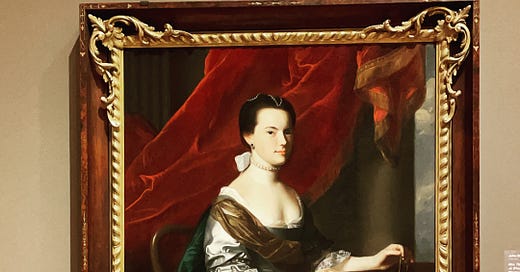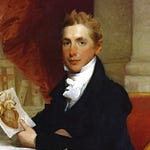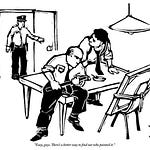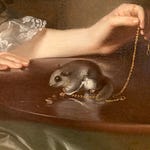Dear Friends,
Greetings again from Bentonville, Arkansas, at Crystal Bridges Museum of American Art, where I am immersed in the Tyson Think Tank. And also enjoying the fruits of warm summer in the heartland, which means hen of the woods mushrooms, peaches, tomatoes, corn, art, nature, and healing. Maybe it’s the abundant crystals in the earth, maybe it’s the generosity of spirit in the community here, and maybe it’s the deer grazing in the backyard of my house, a simple and pleasant abode with no stuff. I kneel at the altar of George Carlin’s routine on stuff, all the more true for me as I have, in the past year, moved from a house in New York City with all of the stuff to live a city life, to a cottage in Putnam Valley to live with less stuff during the pandemic, to South Bend Indiana to serve a fine museum with even less of my stuff, to Bentonville, Arkansas, with a fraction of that stuff. Here, my stuff is minimal, just essentials and even so feeling like I have too much stuff. For goodness sake, I’m typing on a Macbook, looking at notes on an iPad and a notebook because I like keyboard and pens and paper.
I would say I digress, but I’m right on target. While here, focused on one work of art, Copley’s portrait of Frances Deering Atkinson, my mind wanders constantly, bringing my emotional and intellectual stuff to a place where I actually need no stuff. I first heard the term continuous partial attention in a meditation led by Sharon Salzberg at the Tibet Institute in New York. I came to find that the term was coined by Linda Stone, a former big tech executive (Microsoft and Apple), to help us understand that multi-tasking--the ability to do two or more things at once--is relatively normal, continuous partial attention is manic, that’s my word. Her more articulate explanation is that “continuous partial attention is an always on, anywhere, anytime, any place behavior that creates an artificial sense of crisis. We are always on high alert.” Right? If I’m taking time to sit in front of a painting in a museum with focus and intent concentration, something else in my life might be boiling over.
This weekend, I spent a total of 6 hours sitting with the object of my study, a stunning portrait that deserves my attention. And yet my project was not simply to look, but to watch others looking. Visitors to the galleries at Crystal Bridges who stopped, looked, spoke. My plan was to engage, to ask questions--what do you see that relates to your life experience, what do you see, what do you think or wonder. In practice, in reality, I was so transfixed by individual looking at the portrait that I became a voyeur, sitting on my camp stool with my notebook listening in, watching others look, smiling from behind my mask--oh there is an entirely other essay I could write about not being able to see facial expressions, theirs or mine, in a museum with safe protocols for visitation. “She’s so pretty.” “Oh it’s a squirrel, not a mouse.” “What a beautiful frame.” “I wonder how it got here.” I counted seconds. The longest a person stayed in front of the painting was 6 seconds. Most far less. Some took pictures of the label, perhaps saving the text for study when they got home. Some took selfies with her or stood in front of her so they were with the table and the squirrel. And then moved on to the next work of art.
I had an epiphany of sorts, even after all of my talking here about close looking, that I had actually forgotten what I know. That my training in close looking came from a professor who was not my professor, but my friend, mentor, encourager. In the 1980s, Jules Prown, a distinguished scholar at Yale outlined the importance of close looking, he framed what we came to know as material culture, art as evidence, a means of connecting objects to the world in which it was created before jumping to the world in which it now exists. That’s a gross oversimplification of a theory that has been debated in smart circles again and again, most seductively in captivating essays by Martin Berger and Jennifer Greenhill, who lean into close looking and then look away in twists and turns. Before I get into material way over my head, I’ll pivot to admire and to say that we all know that looking closely at anything has its perils, and looking away or askance or from a distance adds perspective.
Here’s another way of putting it, more my increasingly contemplative speed. When I was a little girl, my mother arranged magical birthday parties, full of fun and games way beyond any pin-the-tail-on-the-donkey shenanigans. She would set up a table covered with stuff--yes stuff again--flowers and fruit and pens and small plastic animals and household utensils and ribbons and such. She would ask us to sit and look for a few minutes, it felt like an eternity. Then she would throw a tablecloth on top of the stuff, covering all of it, and ask us to draw what we had seen. A memory game at the time that I now recognize as my early training in close looking. Even back then, without technological distractions, most of us said “what!?!” I was thinking about the cake or my dress or something else. I didn’t know I would have to remember anything. Many, many years later, I played this game in the galleries of The Met with students, looking at a painting for a long time (5 minutes) and asking them to turn their backs and draw or write what they had seen. Nothing new under the sun, the savvy Harvard professor Jennifer Roberts started doing this with her American art students about a decade ago, focusing on immersive attention, assigning her students to sit in front of a single painting for nine minutes, espousing the value of looking for a long time. Jennifer’s colleague Shari Tishman has coined the term “slow looking,” to help us capture information that is simply not accessible through high-speed transmissions or continuous partial attention.
And onward
I have a lot to say about Frances’s squirrel, the one in the painting and the ones on the beautiful, natural grounds here in Arkansas. More on that during the week.
Take a walk
Until then, keep walking and looking, slowly and with curiosity and courage,
Carrie














Share this post